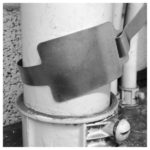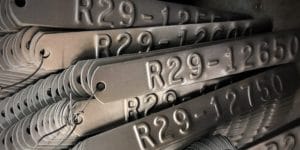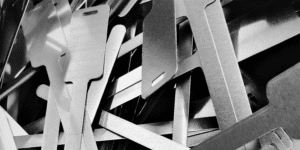Industrial identification doesn’t stop at equipment, tools, and parts. Cables, bunches of wires, and even pipes are marked with metal wire tags.
While marking a machine with a nameplate and some screws is pretty straightforward, identifying rounded objects such as cables and pipes may sound like a challenge.
Fortunately, there are a variety of wire tag solutions suitable for these application types.
Applications
Cables
Marking cables with a custom tag allows for organizations to clearly and accurately provide information to workers. This can be something as simple as a weight limit or tolerance for a cable. While it seems simple, a reminder goes a long way for safety purposes.
In addition, adding a tag to industrial cables can help deter potential theft. A simple company logo or “property of” marker can be all it takes to keep cables from mysteriously disappearing. You can even add contact information in case a cable is lost or needs serviced.
Wires
If you have every worked with wiring, you know how easy it can be to get wires into a jumbled mess. On top of that, if you have multiple people working with wires and they aren’t adequately labeled, it can be very easy for someone to misidentify and make a mistake.
Marking wires allows for quick and easy identification, prevents mistakes, and ensures best practices are followed. In addition, certain types of tags (cable ties) can even be used to sort groups of wires and hold them together at the same time.
Pipes
Tags used for cables and wires are also used for pipes, safety release valves, and other similar applications. These are also cylindrical shaped, making them best suited for tags which wrap around the object and attach.

Durability
Affixing identification markers to a cable in an industrial setting means those tags better be durable. Like most components in this type of environment, wire tags are exposed to a range of elements depending on the industry or specific application.
This can include chemical exposure, wind, rain, sunlight exposure, and abrasion.
For example, on construction sites dust and debris is prevalent. On top of that, outdoor exposure to weather and sunlight means your nameplates have to be durable if they are to hold up for an extended period of time.
The actual level of durability for each tag is primarily affected by the material and process selection. For example, choosing a vinyl printed decal that will be exposed to saltwater on a shipping dock will lead to a label which wears pretty quickly. As opposed to a process which is used to prevent against wear in those environments.
Materials
Some of the most commonly used materials for wire tags include:
- Anodized Aluminum
- Stainless Steel
- Cold Rolled Steel
- Brass
As stated above, knowing your application is crucial in selecting the right material. Certain materials are better suited for some applications than others. If you aren’t sure, ask your tag manufacturer. They typically know what types of environments their various processes are suitable for.
Process Options
Embossing
The embossing process uses a die set to press a raised design upwards in the tag, similar to the marking on a credit card. This makes for an extremely durable tag, which is legible even in the most adverse conditions. Even if the characters are covered in paint or dirt, it is typically still easy to read them.

By using characters formed from the metal itself, there will be no inks or printing to fade or wear away. For tags attached to outdoor cables, wind could cause abrasion against the metal, scraping away a surface etched design as well.
Photo Anodization
If a printed look is more suitable, or you require special information, photo anodization is a great process. This embeds your design between layers of aluminum for high durability.
In addition, any information can be added. This includes logos, images, barcodes, QR codes, and more. The design has the appearance of black printing on the natural aluminum color, but without the worries regarding durability.
If outdoor identification is key, look no further as these nameplates feature 20+ years of outdoor durability. This is in addition to top notch corrosion and abrasion resistance.
Attachment Methods
Cable Ties
One of the most versatile solutions, cable ties can be used for attaching information to a wide range of non-flat surfaces. These tags have a wider section and a long thinner tail. The tail of the tag wraps around a cylindrical object, and feeds through a slot cut out of the wide section. It then folds over itself, creating a firm hold to ensure your information stays attached.
The benefit to using cable ties is that no additional hardware is required to affix them to your desired location. (A bolted on tag requires additional screws/bolts.)

However, these tags are not unbreakable. They must be produced with thin material to allow for the flexibility to wrap around a surface. In addition, the fold over attachment method is not secure enough to withstand extreme force. For the majority applications, this is not a concern.
Wire
For tag types other than cable ties, there are other solutions for attachment. One of the most popular solutions is using a wire. Nameplates can be produced with any number of holes in them, allowing for a wire to slip through.
The wire then wraps around the cable, wiring, or other object which needs marked. This allows tags to be attached to intricate surfaces like valves and special tools.
Wrap Up
While sometimes it may seem there is not a solution for your identification needs, there always is one. Whether you need to mark a wire or cable, plumbing pipe or valve; wire tags provide an easy and effective method for attaching your information.